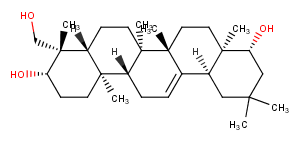Powder: -20°C for 3 years | In solvent: -80°C for 1 year


Soyasapogenol B has anti-cancer, hypocholesterolemic, anticomplementary, hepatoprotective effects, it inhibits proliferation of cultured Hep-G2.

| Pack Size | Availability | Price/USD | Quantity |
|---|---|---|---|
| 1 mg | In stock | $ 64.00 | |
| 5 mg | In stock | $ 189.00 | |
| 10 mg | In stock | $ 296.00 | |
| 25 mg | In stock | $ 539.00 | |
| 50 mg | In stock | $ 772.00 | |
| 100 mg | In stock | $ 1,050.00 | |
| 1 mL * 10 mM (in DMSO) | In stock | $ 223.00 |



| Description | Soyasapogenol B has anti-cancer, hypocholesterolemic, anticomplementary, hepatoprotective effects, it inhibits proliferation of cultured Hep-G2. |
| In vitro | Glycyrrhizin showed significant dose-dependent protective effects against the cytotoxicity of t-BuOOH. Among Soyasapogenol B and its glucuronides, the monoglucuronide showed the most potent hepatoprotective activity, followed by Soyasapogenol B itself. Soyasaponin III was weakly protective, while soyasaponin I increased the toxicity of t-BuOOH. Among sophoradiol and its glucuronides, sophoradiol itself showed the most potent hepatoprotective activity, which was equal to glycyrrhizin, while the monoglucuronide and kaikasaponin III showed an increase in cytotoxicity. These results were considerably different from those reported previously on the protective effects of these compounds using primary cultures of immunologically injured rat liver cells[1] |
| Source |
| Molecular Weight | 458.72 |
| Formula | C30H50O3 |
| CAS No. | 595-15-3 |
Powder: -20°C for 3 years | In solvent: -80°C for 1 year
DMSO: 27.5 mg/mL (59.95 mM)
You can also refer to dose conversion for different animals. More
bottom
Please see Inhibitor Handling Instructions for more frequently ask questions. Topics include: how to prepare stock solutions, how to store products, and cautions on cell-based assays & animal experiments, etc.
Soyasapogenol B 595-15-3 Apoptosis Autophagy Inhibitor inhibit inhibitor
